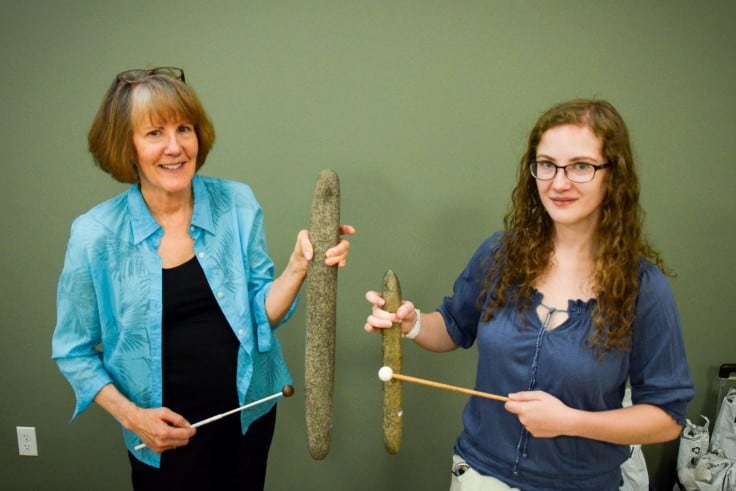Music. It’s one of the oldest tools known to medicine. It profoundly affects our cognitive, physical, emotional, and social experiences.
That’s probably why there’s such a rich history of using music as therapy for many afflictions for millenia. Yes, thousands of years! And below, we’re going to discuss it in five minutes.
Take a walk with us through the history of music as medicine.
6,000 years ago:
An archaeological dig in iLs’ home state of Colorado recently unearthed rocks that had clearly been sculpted by human hands as a tool of some sort. Their purpose? Music. Yes, even 6,000 years ago when ancient peoples organized their days around survival, music served an important purpose. Could this be where the term “rock and roll” originated?
Click here to “hear” the rocks.
2,500 years ago:
The therapeutic value of music has been documented as far back as the 6th century BC. First, consider that Apollo is both the god of music and the god of medicine.
Greek philosophers Plato, Aristotle, and Pythagoras prescribed musical pieces tailored specifically for their patients and recommended a daily listening practice. For instance, dulcimer music was used for depression and calming flute music for patients in manic states.
Not only did they consider music curative, but also central to personal education. They correctly predicted that learning a musical instrument enhanced cognition and even produced better educated and skilled citizens; a music benefit that is still relevant and proven today.
“Music is a moral law. It gives soul to the universe, wings to the mind, flight to the imagination, and charm and gaiety to life and to everything.”
– Plato
500-1,500 years ago (The Middle Ages):
Despite the fact that medicine in the Middle Ages was infamous for the liberal use of bloodletting leeches, music was still upheld for its therapeutic value. Religious leaders of the time considered music a tool to affect emotions and bring worshipers a higher awareness. Individuals with psychiatric disorders were treated with music and it was believed that several illnesses (one example: tarantism, an illness caused by the bite of a tarantula) could be cured through a musical composition designed to purify the blood. In fact, this is the origin of the tarantella dance.
300-700 years ago (The Renaissance):
Depression and mania continued to be targets of music as medicine during the Renaissance but other uses emerged. Music was conceived of as a regulator of normal body function. As such, its uses were expanded to include pain relief and treatment of the plague.
Current day:
Skipping forward several centuries, music remains a meaningful tool today. The fact that it is both non-invasive and non-pharmacological makes it appealing in many healing disciplines.
To highlight just a few:
- The earliest known reference to music therapy appeared in 1789: an article in Columbian Magazine titled Music Physically Considered. The first recorded music therapy intervention & systematic experiments in music therapy were conducted in the 1800s.
- Music and Memory is a non-profit organization bringing personalized music to people with dementia long-term care facilities to help them find renewed meaning and connection in their lives. This trailer of the documentary Alive Inside about Music and Memory gives a glimpse of the possibility of music to tap into deep memories and reconnect with family, friends and caregivers.
- A study conducted at Beth Israel Medical Center, the findings of which were published in Pediatrics, found that live music can have benefits for premature babies. Music therapists cooperating with the hospital reworked popular songs into lullabies to soothe the babies. They found that, when exposed to live music—played or sung—the infants’ heartbeats slowed, their breathing became calmer, and they improved sucking behaviors. Overall, music relaxed the infants and, according to anecdotal evidence, infants exposed to live music tended to leave the hospital sooner.
- iLs! iLs was founded in Denver, CO in 2007 as the first neurotechnology company to systematically integrate music, movement and language activities for the purpose of improving brain function. We have since trained more than 10,000 therapists and educators in more than 50 countries around the world. Our mission is to help individuals of all ages elevate their quality of life by improving brain function and emotional resilience through music, movement, technology and education.
- Unyte (formerly Wild Divine) acquired iLs in 2019 and has integrated as one team with the purpose of helping people transform from struggling to thriving. Unyte has helped individuals train their breath to stay more calm and regulated with the Interactive Meditation (iom2) a real-time biofeedback and heart rate variability device and 100+ Interactive Journey’s. Together, Unyte-iLs have a family of evidence-based neural solutions for at-home and in-clinic.
Questions? Comments? Concerns?
We’d love to hear from you!





 © 2025 Unyte Health US Inc.
© 2025 Unyte Health US Inc.